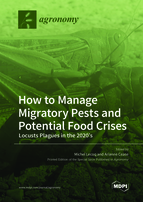How to Manage Migratory Pests and Potential Food Crises: Locusts Plagues in the 2020’s
A special issue of Agronomy (ISSN 2073-4395). This special issue belongs to the section "Pest and Disease Management".
Deadline for manuscript submissions: closed (31 August 2021) | Viewed by 80875
Special Issue Editors
Interests: locusts; grasshoppers; locust control; locust biology; locust ecology
Special Issues, Collections and Topics in MDPI journals
Special Issue Information
Dear Colleagues,
Locusts (Orthoptera: Acridoidea) constitute a threat to agriculture and livelihoods in many countries globally. The economic, social, and environmental consequences of these highly migratory pests are so substantial that they are treated as a national priority by many countries and several international commissions have been established to unite efforts. The start of 2020 was marked by the continued South American locust upsurge—the first major upsurge of this species in 60 years, as well as the onset of a dangerous desert locust invasion now extending from Kenya to India—the first many of these countries have seen in decades. This special issue aims to shed light on the overarching questions: What have we learned from historical outbreaks, what research is ongoing and what is needed, how serious is the current threat, and how should the world respond to plagues today? Articles in this special issue may address locust issues concerning any of the following: biotic and abiotic factors that affect population and/or behavioral dynamics including the potential role of climate change, surveys and monitoring, forecasting, management technologies, governance including the capacity of affected countries to respond, the impact of outbreaks (economic, social, and/or environmental), or related research. Specific questions authors may wish to consider include: What are the primary drivers of the current outbreaks and is climate change involved? Are recommended preventative strategies effective and what are the constraints to their application? Is there a possibility to use biological alternatives to chemical pesticides? What additional research is needed to better manage these insects? Papers addressing similar topics for other transboundary migratory pests are also welcome.
Dr. Michel Lecoq
Dr. Arianne Cease
Guest Editors
Manuscript Submission Information
Manuscripts should be submitted online at www.mdpi.com by registering and logging in to this website. Once you are registered, click here to go to the submission form. Manuscripts can be submitted until the deadline. All submissions that pass pre-check are peer-reviewed. Accepted papers will be published continuously in the journal (as soon as accepted) and will be listed together on the special issue website. Research articles, review articles as well as short communications are invited. For planned papers, a title and short abstract (about 100 words) can be sent to the Editorial Office for announcement on this website.
Submitted manuscripts should not have been published previously, nor be under consideration for publication elsewhere (except conference proceedings papers). All manuscripts are thoroughly refereed through a single-blind peer-review process. A guide for authors and other relevant information for submission of manuscripts is available on the Instructions for Authors page. Agronomy is an international peer-reviewed open access monthly journal published by MDPI.
Please visit the Instructions for Authors page before submitting a manuscript. The Article Processing Charge (APC) for publication in this open access journal is 2600 CHF (Swiss Francs). Submitted papers should be well formatted and use good English. Authors may use MDPI's English editing service prior to publication or during author revisions.
Keywords
- Locusts
- Pests
- Outbreaks
- Invasions
- Monitoring and forecasting
- Preventive management strategy
- Food crisis
- Biological control
- Sustainability







